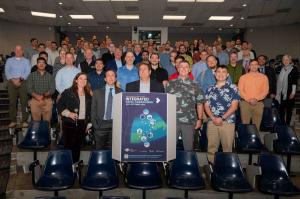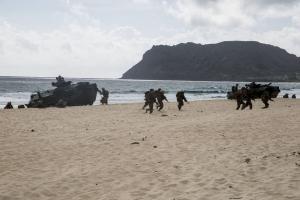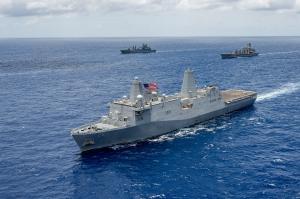NPS' Warfare Innovation Continuum Drives Students' Concept Generation

During the past year, students at the Naval Postgraduate School examined the art of the possible for Integrated Naval Campaigning during the latest cycle of the school’s Warfare Innovation Continuum, which supports the advancement of naval concepts and capabilities.

In September 2023, the Naval Postgraduate School's Warfare Innovation Continuum Workshop kicked off the Fiscal Year 2024 WIC cycle with a focus on “Integrated Naval Campaigning.”

One of the concept generation teams participating in the Fiscal Year 2024 Naval Postgraduate School Warfare Innovation Continuum Workshop presents its findings to NPS students and faculty and representatives from the fleet and industry during a brief in September 2023.
MONTEREY, CALIFORNIA, UNITED STATES, August 22, 2024 /EINPresswire.com/ -- The Naval Warfare Studies Institute (NWSI) at the Naval Postgraduate School (NPS) recently completed the latest cycle of its annual Warfare Innovation Continuum (WIC), a 12- to 18-month interdisciplinary exploration of a central theme of naval interest achieved through various research projects, capstone class projects, experiments, workshops and seminars.
Leveraging classroom work in wargaming, modeling, simulation and red teaming, each WIC cycle supports the advancement of naval concepts, the assessment of new technologies, and the development of new tactics, all while enhancing NPS students’ educational experiences and sharpening their combat skills.
This year’s WIC campaign of analysis, entitled “Integrated Naval Campaigning,” was a resounding success, according to retired U.S. Navy Capt. Jeff Kline, NWSI WIC Director and Operations Research Professor of Practice at NPS.
“At the CNO’s Futures Wargame, I briefed the Chief of Naval Operations and other Navy leadership on an alternative force design specifically for sea control that was based on our campaign of analysis during the WIC,” Kline said. “The alternative fleet took ideas from the workshops we held, from our joint campaign analysis class and from a wargame we just completed, all of which dealt with integrated naval campaigning. The CNO’s staff is now looking at an alternative force design to their program forces. I don’t think you can get a better mark of success than that.”
He added, “As an educator, however, I would say our real product here is at least 200 student officers who now think differently about how they would fight with the fleet and how they build the fleet. The WIC’s real success is that we integrate it with NPS’ educational mission.”
The Navy’s Warfare Development Division (OPNAV N72), which is responsible for the development of Navy strategy and concepts that are aligned with emerging security trends, higher-level guidance, and the tenets of the Navy’s national security role, originally requested NWSI explore the topic of integrated naval campaigning.
From the amphibious operations of World War II to the counter-piracy operations of today, integrated naval campaigning – a series of linked tactical operations in, and from, the maritime domain conducted by joint, inter-organizational and allied forces – has played a critical role in achieving the nation’s strategic and operational objectives.
The dawn of the robotics age of warfare, however, has brought new challenges and opportunities for new concepts across all warfighting domains.
For the Fiscal Year (FY) 2024 WIC, NWSI specifically set out to answer the design challenge: “How might the confluence of new technologies provide opportunities for new operational concepts in executing integrated naval campaigning across the full spectrum of conflict?”
Three courses were conducted over the FY 2023 Summer Quarter to initially define the problem set, each addressing a unique aspect of the theme: Joint Campaign Analysis, Information Warfare Systems Engineering and Networked Autonomous and Unmanned Systems.
These inputs provided critical information for the kickoff of the FY 2024 WIC, the 14th annual WIC Workshop, held Sept. 18-21, 2023. This intense concept generation workshop employed Warfighter Centered Design methods to explore the art of the possible of integrated naval campaigning along eight lines of effort: 21st Century Amphibious Operations, Maritime Gray Zone Operations, Coalition Operations, Undersea Operations, Contested Logistics, Future Vertical Take-Off and Landing Operations, Advanced Mining Operations and Long-Range Fires.
Each of these topics was taken up by a team of NPS students and early career professionals from across the fleet, Navy laboratories, industry and academia in the context of a notional future conflict scenario.
“We generate a future fictional scenario every year to tether our work to the workshop and WIC throughout the year,” said Lyla Englehorn, NWSI warfighting concepts lead. “This larger worldwide scenario provides our students and research faculty the relevance of what they’re trying to do, whether it’s viscous fluid in a robotics arm or conceiving a new strategy for Southeast Asia.”
The ideas and concepts the teams developed were then vetted by government, military, industry and academic leaders, as summarized in NWSI’s Final Report on the 2023 WIC Workshop.
“With over 100 individuals attending from warfare labs, industry, warfare development centers, fleet staffs, the Pentagon, and our own faculty and students, we obtained a diverse set of technical, engineering, and operational talent to generate concepts for employing emerging and existing technologies in operational environments,” Kline said. “The workshop then serves as the cornerstone of events that occur across the NPS campus throughout the remainder of the year.”
Working together with NPS’ Office of Research and Innovation (OR&I) under the operating concept of the Naval Innovation Center, NWSI leverages the workshop to cultivate a vibrant innovation ecosystem at NPS.
In addition to follow-on wargaming and joint analysis courses which dealt with specific questions associated with integrated naval campaigning, the concepts generated in the workshop informed research through the Naval Innovation Exchange (NIX), a networked organization under OR&I that coordinates teams of faculty, students and partners working in research “sprints.” Associated technologies were also experimented with at the quarterly Joint Interagency Field Experimentation (JIFX) events.
“We then have larger research projects that in some way inform the larger topic of integrated naval campaigning,” Kline noted, including 2024 Total Ship Systems Engineering Design, various CRUSER innovation and research projects, Force Design for Sea Control Fleet Campaign of Analysis, NPS research and innovation groups, as well as individual theses.
Kline added that the concepts and follow-on work are also carried beyond NPS, including across the fleet, OPNAV sections, the Marine Corps Warfighting Lab (MCWL) and Naval Surface Warfare Centers (NSWC).
“The central theme here is that we’re thought leaders; we lead the thought processes,” Kline said. “We provide the initial seeds and concepts in order to inform these organizations’ official concept developments and campaigns of learning for those developments.”
The WIC’s primary importance is that it empowers NPS students and early career engineers at the warfighting labs to realize that their bottom-up driven ideas are valid and potentially as impactful or influential as those being directed top-down, according to retired Marine Corps Col. Randy Pugh, NPS Vice Provost for Warfare Studies and director of NWSI.
Being able to enter a creative space and think unconstrained about the subject at hand not only generates new ideas, but also creates a culture of constant intellectual curiosity and allows people to think about things critically and propose new ways of doing things.
“As the Marines like to say, ‘Good ideas know no rank,’” he said. “The WIC both directly contributes to the problem set and changes the culture so that we’re not just trying to predict the future, but we’re also creating leaders that are adaptive and who, when faced with something they hadn’t predicted or expected, can quickly say, ‘Hey, let’s get together and talk about this: where are we, where do we want to be, and what are some of the things we might try in order to do that?’”
“Even if there was no direct result of WIC – some new capability, concept or policy – the ultimate product is the people that participated in it,” Pugh added.
For the Systems Engineering Analysis (SEA) 33 capstone team, that product was 22 members from multiple NPS degree programs, as well as students from the National University of Singapore’s Temasek Defence Systems Institute (TDSI). Members included officers from the U.S. Navy, U.S. Army, Brazilian Air Force, Taiwanese Navy, Israeli Defense Force, and Singapore Army, as well as U.S. and Singapore Navy civilians.
The team, tasked by the Warfare Integration Directorate for the Office of the Chief Naval Operations (OPNAV N9I) with exploring the Advanced Mining Operations line of effort, was led by Navy Cmdr. Erik Kowalski, a career pilot of the MH-53E “Sea Dragon,” the Navy’s dedicated Airborne Mine Countermeasures (AMCM) platform.
“We started out looking at next-generation, innovative concepts in mining to help feed some of our ideas of potential directions to go,” Kowalski said. “For the first (Fall) quarter, we focused on framing the problem, understanding how best to approach it, coming up with some basic concepts of operations to downselect from, and then we built an initial functional architecture that we thought we’d need.”
The team refined these at the WIC Workshop into several formal concepts, which evolved into the design and analysis of self-mobile mines.
The incorporation of self-mobility into sea mines can potentially provide numerous benefits over traditional, static mines that could not only improve lethality and counter-mobility effects, but could also aid in mine delivery, minefield flexibility, tactical employment and minelayer safety.
“Traditional mines normally sit on the sea floor and don’t move, so if an enemy comes in and clears a path, that path is clear until you reseed it or something else happens,” Kowalski explained. “The idea behind mobile mines is that the minefield is smart enough that once the minesweepers have come in and cleared that path, the other mines that are in the minefield can then move in that path and essentially keep reseeding it themselves.”
Over the Winter Quarter, the team focused on the physical architecture of self-mobile mines and developing concepts of operations of scenarios that they could test against in simulations. Finally, in the Spring Quarter, they concentrated on the modeling, simulation and data analysis using the Navy’s Modeling and Simulation Toolbox (MAST) software. They also performed a cost-benefit analysis and feasibility study for the design.
The team presented their final brief and report to OPNAV N9I in early June, where it will specifically inform them in their work on advanced mining and offensive mining capabilities.
The primary take-away, Kowalski said, is that with current technologies, the design is entirely feasible.
“We could build self-mobile mines right now,” he said. “Not only would you get the advantages from them being able to move and close gaps based on the patterns of life of the enemy, but also the mobility itself would give us a lot of delivery options that traditional mines don’t necessarily provide.”
“If mines could navigate themselves, really you just have to be able to get the mines in the water close enough and they can do all the hard work to get into the field and position themselves,” he added.
The 21st Century Amphibious Operations line of effort was conducted to support the Marine Corps’ foundational concept development set forth in its Force Design modernization effort.
The team, led by Pugh, consisted of four NPS students, two NPS faculty, and eight guests from warfare centers, MCWL, a systems command and industry.
Meeting up at the WIC Workshop, they were presented with the hypothesis that “in 2040-45, amphibious forces will support maritime campaigning by controlling key maritime terrain.”
“We set out to generate an understanding of the challenges and ideas about how we might close the gap between the current state and the desired future state, given disruptive emerging technologies, future missions and future adversaries,” Pugh said.
The development of adversaries’ long-range intelligence, surveillance and reconnaissance (ISR) capabilities and long-range precision weapons systems, for example, call into question the very survivability of current means of conducting amphibious operations.
“In a nutshell, how are we going to get Marines from ship to shore? How are we ensuring the survivability of the Navy-Marine Corps team holistically, whether that is at sea or after we get the Marines to shore?” said Marine Corps Capt. Karl Flynn, an infantry officer and recent graduate from NPS in computer science.
Flynn and two fellow Marines – Capt. Harrison Rashley, also an infantry officer and computer science student, and Maj. Steven Anderson, a reconnaissance officer and space systems operations student – brought a wealth of recent operational experience to the table at the WIC Workshop.
“We all have fairly significant experience in the Pacific and understand the greater sense of urgency and have a bigger respect for the holistic problem because we’ve lived it, especially deploying on a (Marine Expeditionary Unit) with the Chinese following you in and out of port,” Rashley said.
“Being involved with the Workshop to help inform future amphibious concepts was good because we were able to bring our current experience and think about the things that we want to have in the future, and then also be challenged by people that are in industry and the architectural engineers to tell us whether or not this is actually possible,” he continued.
Over the course of the workshop, the team generated two innovative concepts to support future amphibious operations: a Highly Distributable Rapid Assault (HiDRA) family of ship-to-shore connectors supporting transport and landing force defense, and a network of autonomous surface, subsurface and aerial vehicles (UxVs).
“Our idea for HiDRA was basically to take all the supplies that we needed for conducting amphibious operations and, instead of putting them all in a big gray-hull amphibious ship, putting them all in small transports that are either hard to detect or really, really fast and then infiltrating the supplies with unmanned underwater vehicles that move to whatever landing site we’ve selected and loiter on the bottom waiting for the landing force,” explained Flynn.
Wing-in-ground effect craft, capable of a speed of a couple of hundred knots, would then proceed to the objective to deliver the landing force, which could immediately move out without having to wait for follow-on supplies.
Separately, the UxV network would assist the Marines in getting to shore and engaging the enemy.
“We were thinking of an architecture that supports getting amphibious ships to a point where they can safely drop things off,” Rashley said. “Essentially, you’d have a sensing force and a shooting force arrayed in time and space that allows your decision-makers to make a decision based on the enemy’s location and actions.”
“The network would be connected by different nodes that would allow us to maintain constant communication,” he continued. “The end state would be that the full formation is more survivable, and we can get it to where we need it to be.”
Since September, research has been led by members of MCWL and Naval Surface Warfare Center Carderock, which continues to refine concepts that support 21st Century Amphibious Operations.
The 2024 WIC Workshop, scheduled for Sept. 23-26, will focus on challenges to “Non-Permissive Global Sea Control” and related issues essential to the Navy’s wartime mission where control of operational maritime environments is necessary to meet integrated naval and joint campaign objectives.
The year-long theme was requested by OPNAV N72 and will strive to answer the design challenge: “How might emerging technologies, existing capabilities, and new operational force employment create opportunities to enhance the Navy’s ability to deter adversaries, or ensure use of the maritime domain in non-permissive environments?”
The 2024 WIC will cultivate fresh ideas and concepts from multidisciplinary teams from across academia, industry, and the military, both U.S. and international. Ten potential lines of effort have already been identified, including Maritime Domain Awareness for Sea Control, Logistics to and in the Weapons Engagement Zone, Expeditionary Advanced Base Operations for Sea Control, and Command and Control (C2) for Decision Advantage.
Lt. Cmdr. Ed Early
Naval Postgraduate School
+1 831-656-3567
PAO@nps.edu
Legal Disclaimer:
EIN Presswire provides this news content "as is" without warranty of any kind. We do not accept any responsibility or liability for the accuracy, content, images, videos, licenses, completeness, legality, or reliability of the information contained in this article. If you have any complaints or copyright issues related to this article, kindly contact the author above.


